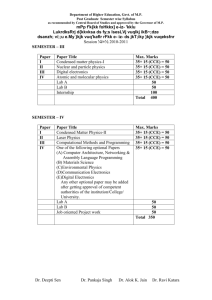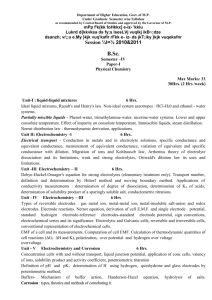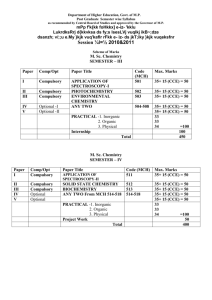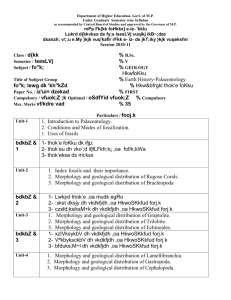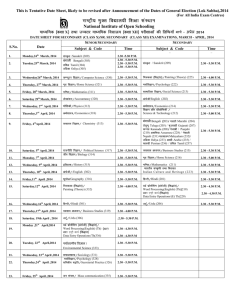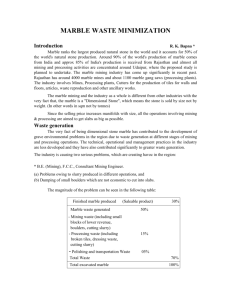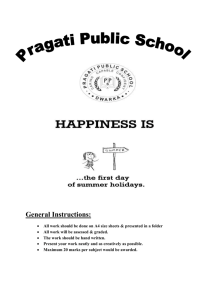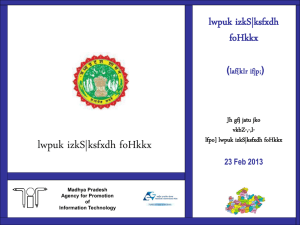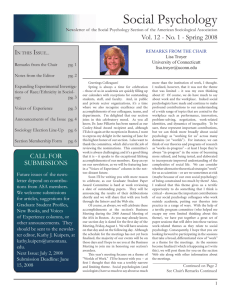Botany
advertisement
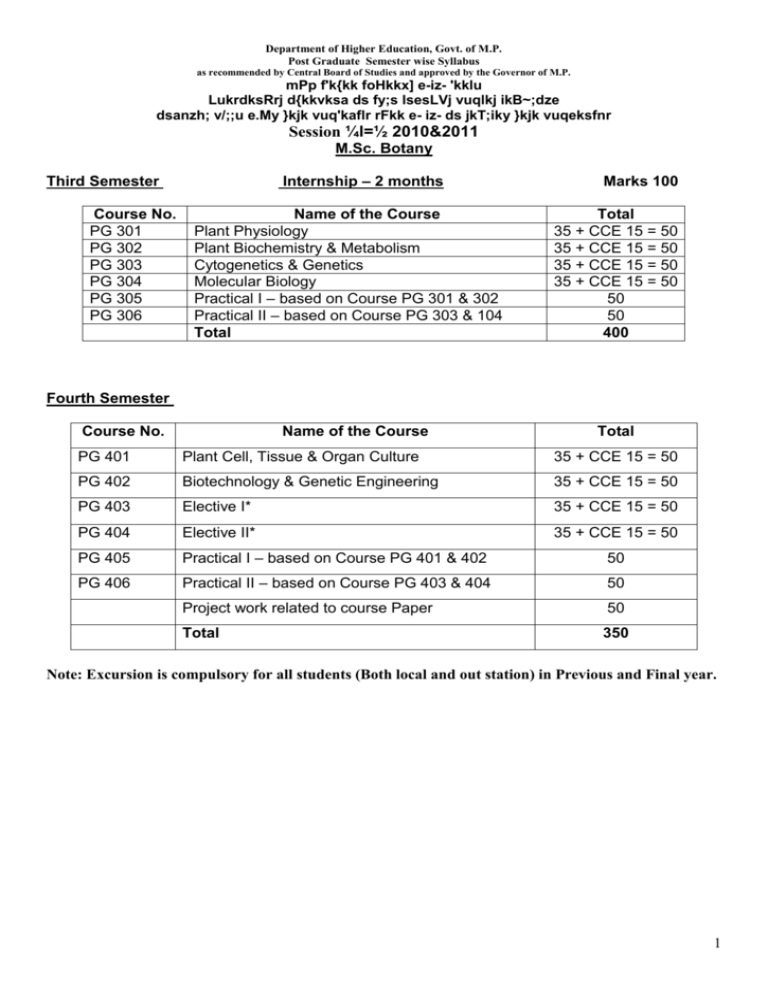
Department of Higher Education, Govt. of M.P.
Post Graduate Semester wise Syllabus
as recommended by Central Board of Studies and approved by the Governor of M.P.
mPp f'k{kk foHkkx] e-iz- 'kklu
LukrdksRrj d{kkvksa ds fy;s lsesLVj vuqlkj ikB~;dze
dsanzh; v/;;u e.My }kjk vuq'kaflr rFkk e- iz- ds jkT;iky }kjk vuqeksfnr
Session ¼l=½ 2010&2011
M.Sc. Botany
Internship – 2 months
Third Semester
Course No.
PG 301
PG 302
PG 303
PG 304
PG 305
PG 306
Name of the Course
Plant Physiology
Plant Biochemistry & Metabolism
Cytogenetics & Genetics
Molecular Biology
Practical I – based on Course PG 301 & 302
Practical II – based on Course PG 303 & 104
Total
Marks 100
Total
35 + CCE 15 = 50
35 + CCE 15 = 50
35 + CCE 15 = 50
35 + CCE 15 = 50
50
50
400
Fourth Semester
Course No.
Name of the Course
Total
PG 401
Plant Cell, Tissue & Organ Culture
35 + CCE 15 = 50
PG 402
Biotechnology & Genetic Engineering
35 + CCE 15 = 50
PG 403
Elective I*
35 + CCE 15 = 50
PG 404
Elective II*
35 + CCE 15 = 50
PG 405
Practical I – based on Course PG 401 & 402
50
PG 406
Practical II – based on Course PG 403 & 404
50
Project work related to course Paper
50
Total
350
Note: Excursion is compulsory for all students (Both local and out station) in Previous and Final year.
1
Department of Higher Education, Govt. of M.P.
Post Graduate Semester wise Syllabus
as recommended by Central Board of Studies and approved by the Governor of M.P.
mPp f'k{kk foHkkx] e-iz- 'kklu
LukrdksRrj d{kkvksa ds fy;s lsesLVj vuqlkj ikB~;dze
dsanzh; v/;;u e.My }kjk vuq'kaflr rFkk e- iz- ds jkT;iky }kjk vuqeksfnr
Session ¼l=½ 2010&2011
Class / d{kk
Semester / lsesLVj
Subject / fo"k;
Title of Subject Group
% M. Sc.
% III semester
% Botany
% Plant Physiology
fo"k; lewg dk 'kh"kZd
%
Paper No. / iz'ui= dzekad
% PG 301
Compulsory / vfuok;Z ;k Optional / oSdfYid vfuok;Z
% Compulsory
Max. Marks vf/kdre vad
% ++35 +CCE 15=50
Particulars / fooj.k
Unit-1
Structure and functions of ATP, Plant water relations, mechanisms of water
transport through xylem, root-microbe interactions in facilitating nutrient uptake.
Membrane transport proteins.
Unit-2
Phloem transport; phloem loading and unloading, passive and active solute
transport. Signal transduction; overview, receptors and proteins, phospholipids
singaling, role of cyclic nucleotides, calcium-calmodulin cascade. Specific
signaling mechanisms, for example, two-component sensor regulator system in
bacteria and plants.
Unit-3
Plant growth regulators and elicitors: Physiological effects and mechanism of
action of auxins, gibberellins, cytokinins, ethylene, abscisic acid, brassinosteroids,
polyamines, jasmonic acid, and salicylic acid. Hormone receptors.
Unit-4
Flowering process: photoperiodism and its significance, endogenous clock and its
regulation. Floral induction and development. Phytochromes and cryptochromes,
their photochemical and biochemical properties, Role of vernalization.
Unit-5
Stress physiology: Plant responses to biotic and abiotic stress. Water deficit and
drought resistance. Salinity stress and resistance. Concepts of freezing, heat and
oxidative stresses.
Suggested Laboratory Exercise based on P.G 301 :
1. Radioisotope methodology, autoradiography, instrumentation (GM counter & scintillation
counter) and principles involved.
2. Principles of colorimetry, Spectrophotometry and florimetry.
3. Determine rate of transpiration by Ganong's potometer.
2
Department of Higher Education, Govt. of M.P.
Post Graduate Semester wise Syllabus
as recommended by Central Board of Studies and approved by the Governor of M.P.
mPp f'k{kk foHkkx] e-iz- 'kklu
LukrdksRrj d{kkvksa ds fy;s lsesLVj vuqlkj ikB~;dze
dsanzh; v/;;u e.My }kjk vuq'kaflr rFkk e- iz- ds jkT;iky }kjk vuqeksfnr
Session ¼l=½ 2010&2011
4. Determine rate of respiration in germinating/young buds by Ganong's respirometer.
5. Determine effect of light intensity / wave length on rate of photosynthesis.
6. Determine effect of temperature / pH/Toxins on permiability of cell membrane.
7. Study of physiological apperatus.
8.
Extraction of chloroplast pigments from leaves and preparation of the absorption spectrum of
chlorophylls and carotenoids.
9. To determine the chlorophyll-a / chlorophyll b ratio in C3 and C4 plants.
10. Isolation of intact chloroplasts and estimation of chloroplast proteins by spot protein assay.
11. Bioassay of plant hormones- auxins, ethylene, GA, ABA and Cytokinin.
12. To determine stomatal index, stomatal frequency and percentage of leaf area open through
stomata. Also, to study the effect of ABA on stamatal closure.
Other experiments based on theory paper.
Suggested readings
Hopkins, W.G. 1995. Introduction to Plant Physiology. John Wiley & ,Sons, Inc., New York,
USA.
Moore, T.C. 1989. Biochemistry and Physiology of Plant Hormones (second edition). Springer Verlag, New York. USA.
Nobel, P.S. 1999. Physiochemical and Environmental Plant Physiology (second edition). Academic
Press, San Diego, USA.
Salisbury FB and Ross CW 1991 Plant Physiology IV edition Wdsworth Publishing co. California
USA.
Taiz l and Zeiger E1998 Pant Physiology II Edition. Sinauer Associates Inc. Publisher MS.
Dennis DT and Terpin DH Lefevere DD and Layzell DV 1997 Plant Metabolism II Ed.
Longman England.
Buchanan, B.B.Gruissem, W. and Jones R.L. 2000. Biochemistry and molecular Biology of
plants. American Society of Plants Physiologist, Maryland USA.
3
Department of Higher Education, Govt. of M.P.
Post Graduate Semester wise Syllabus
as recommended by Central Board of Studies and approved by the Governor of M.P.
mPp f'k{kk foHkkx] e-iz- 'kklu
LukrdksRrj d{kkvksa ds fy;s lsesLVj vuqlkj ikB~;dze
dsanzh; v/;;u e.My }kjk vuq'kaflr rFkk e- iz- ds jkT;iky }kjk vuqeksfnr
Session ¼l=½ 2010&2011
Class / d{kk
Semester / lsesLVj
Subject / fo"k;
Title of Subject Group
% M.Sc.
% III semester
% Botany
% Plant Biochemistry & Metabolism
fo"k; lewg dk 'kh"kZd
%
Paper No. / iz'ui= dzekad
% PG 302
Compulsory / vfuok;Z ;k Optional / oSdfYid vfuok;Z
% Compulsory
Max. Marks vf/kdre vad
% 35 +CCE 15=50
Particulars / fooj.k
Fundamentals of enzymology: allosteric mechanism, regulatory and active sites,
Unit-1
isozymes, kinetics of enzymatic catalysis, Michaelis- Menten equation and its
significance, Mechanism of enzyme action.
Photochemistry
and
photosynthesis:
General
concepts,
evolution
of
photosynthetic apparatus, photosynthetic pigments and light –harvesting
complexes. Photooxidation of water, mechanism of electron and proton
Unit-2
transport, Carbon assimilation; Calvin cycle, photorespiration and its
significance,
C4-cycle,
CAM
pathway,
physiological
and
ecological
considerations.
Respiration and lipid metabolism: Overview of plant respiration, glycolysis,
Unit-3
TCA cycle, electron transport and ATP synthesis. Oxidative pentose phosphate
pathway, glyoxylate cycle, alternative oxidase system.
Structure and functions of lipids, fatty acid biosynthesis, structural lipids and
Unit-4
storage lipids and their catabolism. Sulphate uptake, transport and assimilation.
Nitrogen fixation, nitrogen and sulphur metabolism: Overview, biological
Unit-5
nitrogen fixation, nodule formation. Mechanism of uptake and reduction,
ammonium assimilation.
Suggested Laboratory Exercise based on P.G 302 :
1. Effect of time and enzyme concentration on the rate of reaction of enzyme C e.g. acid
Phosphatase, nitrate reductase.
2. Effect of substrate concentration on activity of any enzyme C ( catalase, Amylase)
3. Demonstration of the substrate inducibility of the enzyme nitrate reductase.
4. Determination of succinate dehydrogenase activity, Its kinetics and sensitivity to
inhibitors.
4
Department of Higher Education, Govt. of M.P.
Post Graduate Semester wise Syllabus
as recommended by Central Board of Studies and approved by the Governor of M.P.
mPp f'k{kk foHkkx] e-iz- 'kklu
LukrdksRrj d{kkvksa ds fy;s lsesLVj vuqlkj ikB~;dze
dsanzh; v/;;u e.My }kjk vuq'kaflr rFkk e- iz- ds jkT;iky }kjk vuqeksfnr
Session ¼l=½ 2010&2011
5. Separation of isoenzymes of esterase, Peroxidases by native polyacrylamide gel
electrophoresis.
6. To
demonstrate
photophosphorylation
in
intact
chloroplasts,
resolve
the
phosphoproteins by SDS-PAGE and perform autoradiography desalting of proteins by
gel filtration chromatography embaying Sephadex G-25.
7. Extraction of seed proteins depending upon the solubility.
8. Desalting of proteins by gel filtration chromatography employing Sephadex G-25.
9. Preparation of standard cauve of protein and estimation of protein contents in extracts of
plant material by Lowry's Bradford's method.
10. Fractionation of proteins using gel filtration chromatography by Sephadex G-100 or
Sephadex G-200.
Other experiments based on theory paper.
Suggested readings
Lodish, H., Berk, A., Zipursky, S.L., Matsudaira, P., Baltimore, D. and Darnell, J.
2000.Molecular cell Biology (fourth edition). W.H. ,Freeman and Company, New York
USA.
Moore, T.C. 1989. Biochemistry and Physiology of Plant Hormones (second edition).
Springer -Verlag, New York. USA.
Nobel, P.S. 1999. Physiochemical and Environmental Plant Physiology (second edition).
Academic Press, San Diego, USA.
Salisbury FB and Ross CW 1991 Plant Physiology IV edition Wdsworth Publishing co.
California usa.
Taiz l and Zeiger E1998 Pant Pysiology II Edition. Sinauer Associates Inc. Publisher MS.
Dennis DT and Terpin DH Lefevere DD and Layzell DV 1997 Plant Metabolism II Ed.
Longman England.
Buchanan, B.B.gruissem, W. and Jones R.L. 2000.
Biochemistry and Molecular
Biology of plants. American Society of Plants Physiologist, Maryland USA.
5
Department of Higher Education, Govt. of M.P.
Post Graduate Semester wise Syllabus
as recommended by Central Board of Studies and approved by the Governor of M.P.
mPp f'k{kk foHkkx] e-iz- 'kklu
LukrdksRrj d{kkvksa ds fy;s lsesLVj vuqlkj ikB~;dze
dsanzh; v/;;u e.My }kjk vuq'kaflr rFkk e- iz- ds jkT;iky }kjk vuqeksfnr
Session ¼l=½ 2010&2011
Class / d{kk
Semester / lsesLVj
Subject / fo"k;
Title of Subject Group
% M.Sc.
% III semester
% Botany
% Genetics & Cytogenetics
fo"k; lewg dk 'kh"kZd
%
Paper No. / iz'ui= dzekad
% PG 303
Compulsory / vfuok;Z ;k Optional / oSdfYid vfuok;Z
%Compulsory
Max. Marks vf/kdre vad
%35 +CCE 15=50
Particulars / fooj.k
Genetics of prokaryotes and eukaryotic; genetic recombination in prokaryotes,
Unit-1
genetic transformation, conjugation and transduction in bacteria. Genetics of
mitochondria and chloroplasts; cytoplasmic male sterility.
Genetic recombination and genetic mapping in eukaryotes; Recombination,
independent
Unit-2
recombination.
assortment
and
Chromosome
crossing-over,
mapping,
linkage
molecular
groups,
mechanism
genetic
of
markers,
construction of molecular maps, somatic cell genetics- an alternative approach to
gene mapping.
Mutations: spontaneous and induced mutations, physical and chemical
mutagens, molecular basis of gene mutations. Transposable elements in
Unit-3
prokaryotes and eukaryotes. Mutations induced by transposons, DNA damage
and repair mechanisms.
Cytogenetics of numerical and structural changes of chromosomes. Euploidy,
Unit-4
aneuploidy: origin, meiosis and effect. Cytogenetics of deficiencies., duplication,
inversions and translocation.
Molecular Cytogenetics; Nuclear DNA content, c-value paradox, cot curve and its
significance, restriction mapping – concept and techniques, multigene families
Unit-5
and their evolution. Transfer of whole genome, examples from wheat and
Brassica, Arachis.
Suggested Laboratory Exercise based on P.G 303 :
1. Isolation of DNA & preparation of 'Cot' curve
2. Demonstration of SEM & TEM.
3. Isolation of Mitochondria and its marker enzyme, succinate dehydrogenase (SDH)
6
Department of Higher Education, Govt. of M.P.
Post Graduate Semester wise Syllabus
as recommended by Central Board of Studies and approved by the Governor of M.P.
mPp f'k{kk foHkkx] e-iz- 'kklu
LukrdksRrj d{kkvksa ds fy;s lsesLVj vuqlkj ikB~;dze
dsanzh; v/;;u e.My }kjk vuq'kaflr rFkk e- iz- ds jkT;iky }kjk vuqeksfnr
Session ¼l=½ 2010&2011
4. Demonstration of Mitosis/ Meiosis (Normal & abnormal)
5. To determine Miotic Index in onion root lips cells
6. Demonstration of special chromosomes.
7. Preparation of KARYO TYPE & IDIOGRAM.
8. Experiments on mutation.
9.
Demonstration of aneuploidy, polyploidy etc.
Other experiments based on theory paper.
Suggested Readings:
Atherly, AG. Girton, J.R and Mc Donald, J.E. 1999. The Science of Genetics: SaPosts College
Publishing, Fort Worth, U.S.A.
Burnham, C.R 1962. Discussions in Cytogenetics, Burgess Publishing Co. Minnesota.
Busch. H. and Rothblum. L. 1982. Volume X. The Cell Nucleus rDNA Part A. Academic Press.
Hartl, D.L. and Jones, E. W. 1998. Genetics: Principles and Analysis (4th edition). Jones & Bartlett
Publishers, Massachusetts, USA
Hartl, D.L. and Jones, E. W. 2006. Genetics: Principles and Analysis (5th edition). Jones & Bartlett
Publishers, Massachusetts, USA
Khush, G.S. 1973. Cytogenetics of Aneuploids. Acedemic Press, New York, London.
Lewin: B. 2000 Gene VII. Oxford University Press, New York, U.S.A
Lewis, R. 1997. Human Genetics: Concepts and Applications. (2nd edition). WCB McGraw Hill,
U.S.A
Russel, P.J. 1998. Genetics (5th edition). The Benjamin / Cummings Publishing Company Inc., U.
S. A
Snusted, D. P. and Simmons, M. J. 2000. Principles of Genetics (2nd edition). Jhon Wiley & Sons
Inc., U.S.A
Snusted, D. P. and Simmons, M. J. 2006. Principles of Genetics (3nd edition). Jhon Wiley & Sons
Inc., U.S.A
Lewin, B. 2006, Genes VlI, Oxford University Press, New York.
7
Department of Higher Education, Govt. of M.P.
Post Graduate Semester wise Syllabus
as recommended by Central Board of Studies and approved by the Governor of M.P.
mPp f'k{kk foHkkx] e-iz- 'kklu
LukrdksRrj d{kkvksa ds fy;s lsesLVj vuqlkj ikB~;dze
dsanzh; v/;;u e.My }kjk vuq'kaflr rFkk e- iz- ds jkT;iky }kjk vuqeksfnr
Session ¼l=½ 2010&2011
Class / d{kk
Semester / lsesLVj
Subject / fo"k;
Title of Subject Group
% M.Sc.
% III semester
% Botany
% Molecular Biology
fo"k; lewg dk 'kh"kZd
%
Paper No. / iz'ui= dzekad
% PG 304
Compulsory / vfuok;Z ;k Optional / oSdfYid vfuok;Z
% Compulsory
Max. Marks vf/kdre vad
% 35 +CCE 15=50
Particulars / fooj.k
DNA structure; A, B and Z forms; transcription; plant promoters and transcription
Unit-1
factors; splicing; messenger RNA transport; ribosomal RNA biosynthesis.
Gene structure and expression; genetic fine structure; cis-trans test; fine
Unit-2
structure analysis of eukaryotes; introns and their significance; RNA splicing;
regulation of gene expression in prokaryotes and eukaryotes.
Ribsosomes: structure and site of protein synthesis; mechanism of translation,
Unit-3
initiation, elongation and termination; structure and role of transfer RNA; protein
sorting; targeting of proteins to organelles.
Cell cycle and apoptosis, control mechanisms; role of cyclins and cyclin
Unit-4
dependent kinases; cytokinesis and cell plate formation; mechanism of
programmed cell death. DNA replication in prokaryotes and eukaryotes.
Immunotechniques, In situ hybridization – concepts and techniques, physical
Unit-5
mapping of genes on chromosomes. In situ hybridization to locate transcript in
cell types; FISH; Flow cytometry.
Suggested Laboratory based on PG 304:
1. Isolation of genomic DNA from plant tissue using CTAB (cetyetri methyl ammonium bromide) or
any animal tissue.
2. Isolation of DNA & its quantitation by a spectrophometric method.
3. Restriction digestion of plant DNA, its seperation by Agrose gel electrophoresis and visualization by
ethidium bromide staining.
4. Isolation of RNA and quantitation by a spectrophotometric method.
5. Separation of RNA by Agrose gel electrophoresis and visualization by Et. Br. staining.
6. Immunological techniques : Ouchterlony method, ELISA & western blotting.
7. Isolation of chloroplats and SDS-PAGE. profile of proteins to demarcate the two subunits of
Rubisco.
8
Department of Higher Education, Govt. of M.P.
Post Graduate Semester wise Syllabus
as recommended by Central Board of Studies and approved by the Governor of M.P.
mPp f'k{kk foHkkx] e-iz- 'kklu
LukrdksRrj d{kkvksa ds fy;s lsesLVj vuqlkj ikB~;dze
dsanzh; v/;;u e.My }kjk vuq'kaflr rFkk e- iz- ds jkT;iky }kjk vuqeksfnr
Session ¼l=½ 2010&2011
Other experiments based on theory paper.
Suggested Readings:
Alberts, B. Bray, D. Lewis, J. Raff: M. Roberts, K. and Watson,J. D. 1989 Molecular Biology of the
Cell (2nd edition). Garland Publishing Inc., New York. U. S. A.
Karp, G. 1999 Cells and Molecular Biology: Concepts and Experiments John Wiley & Sons, Inc. U.
S.A
Malacinski, G. M. and Freifelder, D. 1998. Essentials of Molecular Biology (3M edition). Jones
and Barlett Publishers, Inc. London.
Wolfe, S.L. 1993. Molecular and Cellular Biology, WadsworthPublishing Co., California, USA.
Alberts, B., Bray, D., Lewis, J., Raff, M., Roberts, K., and Watson, J.D. 1999.Molecular Biology
of the Cell. Garland Publishing:Inc., New York.
Rost, T. et al. 1 998.Plant Biology, Wadsworth Publishing Co.,California, U.S.A
Krishanmurthy K. V. 2000 Methods in Cell Wall Cytochemistry, CRCPress, Boca Raton, Florida
U.S.A
Buchanan, B.B. Gruissem, W. and Jones, RL. 2000. Biochemistry And Molecular Biology of
Plants. American Society of Plant Physiologists, Maryland, USA
De, D.N. 2000 Plant Cell Vacuoles: An Introduction.CSIRO Publication, Collingwood, Australia.
Kleinsmith, L.J. and Kish, V.M. 1995. Principles of Cell and Molecular Biology (2nd Edition).
Harper Collins College Publishers, New York, USA
Lodish H. Bert, A,zipursky, S.L.,Matsudaira, p.,Baltimore, D. and Darnell, J. 2000.Molecular
Cell Biology, W.H.Freeman and Co., NewYork, U.S.A
Pollard, T. S. and EaJ-nshaw, W. C. 2002 Cell Biology. SaPosts,Philadelphia, U.S.A Twyman, R.
M. 2003. Advanced Molecular Biology. Viva Books Private Ltd. New Delhi.
9
Department of Higher Education, Govt. of M.P.
Post Graduate Semester wise Syllabus
as recommended by Central Board of Studies and approved by the Governor of M.P.
mPp f'k{kk foHkkx] e-iz- 'kklu
LukrdksRrj d{kkvksa ds fy;s lsesLVj vuqlkj ikB~;dze
dsanzh; v/;;u e.My }kjk vuq'kaflr rFkk e- iz- ds jkT;iky }kjk vuqeksfnr
Session ¼l=½ 2010&2011
Class / d{kk
Semester / lsesLVj
Subject / fo"k;
Title of Subject Group
% M.Sc.
% III semester
% Botany Practical Part I
% Plant Physiology, Plant Biochemistry and
Metabolism
fo"k; lewg dk 'kh"kZd
%
Paper No. / iz'ui= dzekad
% Practical based on PG 301 & 302
Compulsory / vfuok;Z ;k Optional / oSdfYid vfuok;Z
%
Max. Marks vf/kdre vad
%50
Botany Practical Scheme for Part – I (Practical based on PG 301 & 302)
Time : 4 hrs
Exercises
1. Exercise based on Major Physiology ………………….. 10
2. Exercise based on Minor Physiology ………………….. 05
3. Exercise based on Biochemistry……………..……..
10
4. Spot 1 to 5 …………………………………………… 10
5. Viva-Voce …………………………………………… 05
6. Sessionals and Record …………………………………..10
Total
Class / d{kk
Semester / lsesLVj
Subject / fo"k;
Title of Subject Group
Biology
50
% M.Sc.
% III semester
% Botany Practical Part II
% Cytogenetics and Genetics, Molecular
fo"k; lewg dk 'kh"kZd
%
Paper No. / iz'ui= dzekad
% Practical based on PG 303 & 304
Compulsory / vfuok;Z ;k Optional / oSdfYid vfuok;Z
%
Max. Marks vf/kdre vad
% 50
Botany Practical Scheme for Part – II (Practical based on PG 303 & 304)
Time : 4 hrs
Exercises
1. Exercise based on Cytology …………………………….. 10
2. Exercise based on Genetics …………………………….... 05
3. Exercise based on Molecular Biology……………..…….. 10
10
Department of Higher Education, Govt. of M.P.
Post Graduate Semester wise Syllabus
as recommended by Central Board of Studies and approved by the Governor of M.P.
mPp f'k{kk foHkkx] e-iz- 'kklu
LukrdksRrj d{kkvksa ds fy;s lsesLVj vuqlkj ikB~;dze
dsanzh; v/;;u e.My }kjk vuq'kaflr rFkk e- iz- ds jkT;iky }kjk vuqeksfnr
Session ¼l=½ 2010&2011
4. Spot 1 to 5 …………………………………………………10
5. Viva-Voce ……………………………………………..….05
6. Sessionals and Record ………………………………..…..10
Total
50
Class / d{kk
Semester / lsesLVj
Subject / fo"k;
Title of Subject Group
% M.Sc.
% IV semester
% Botany
% Plant Cell, Tissue & Organ Culture
fo"k; lewg dk 'kh"kZd
%
Paper No. / iz'ui= dzekad
% PG 401
Compulsory / vfuok;Z ;k Optional / oSdfYid vfuok;Z
% Compulsory
Max. Marks vf/kdre vad
% 35 + CCE 15 =50
Particulars / fooj.k
Plant cell and tissue culture: general introduction, history, scope, concept of cellular
Unit-1
differentiation and totipotency.
Techniques of tissue culture. Organ culture – meristem, anther and embryo. In vitro
Unit-2
fertilization.
Organogenesis and adventive embryogenesis; fundamental aspects of morphogenesis,
Unit-3
somatic embryogenesis and androgenesis. Mechanisms, techniques and utility.
Somatic hybridization, protoplast isolation, fusion and culture, hybrid selection and
Unit-4
regeneration; possibilities and achievements and limitations of protoplast research.
Application of plant tissue culture; clonal propagation; artificial seeds; production of
Unit-5
hybrids, somaclones and somaclonal variation; production of secondary metabolites/
natural products; cryopreservation and germplasm storage.
Suggested Laboratory Exercise based on P.G 401 :
1. Sterilization techniques.
2. Preparation of culture medium.
3. Sterilization of medium.
4. To prepare tissue culture lab.
5. Sterilization of glassware.
6. Preparation of tissue culture medium.
7. Stertization of Explants.
11
Department of Higher Education, Govt. of M.P.
Post Graduate Semester wise Syllabus
as recommended by Central Board of Studies and approved by the Governor of M.P.
mPp f'k{kk foHkkx] e-iz- 'kklu
LukrdksRrj d{kkvksa ds fy;s lsesLVj vuqlkj ikB~;dze
dsanzh; v/;;u e.My }kjk vuq'kaflr rFkk e- iz- ds jkT;iky }kjk vuqeksfnr
Session ¼l=½ 2010&2011
8. Study effect of plant growth hormones (PGR) on tissue culture.
9. To perform the techniques of micro propagation/ somatic embryogenesis /androgenesis.
10. To perform the techniques of organogenesis.
11. Study of applications of tissue culture.
Other experiments based on theory paper.
Suggested Reading
Butenko, R.G. 2000. Plant Cell Culture. University Press of Pacific.
Collin, H.A. and Edwards, S. 1998. Plant Cell Culture. Bios Scientific Publishers, Oxford, UK.
Dixon, R.A. (Ed.) 1987. Plant Cell Culture: A Practical Approach. IRL Press, Oxford.
Gelvin, S.B. and Schilperoort, R.A. (Eds), 1994. Plant Molecular Biology Manual, 2nd edition,
Kluwer Academic Publishers, Dordrecht, The Netherlands.
George, E.F. 1993. Plant Propagation by Tissue Culture. Part 1. The Technology, 2nd
edition.Exeg.etics Ltd., Edington, UK.
George, E.F. 1993. Plant Propagation by Tissue Culture. Part 2. In Practice, 2nd edition. Exegetics
Ltd., Edington UK.
Glick, B.R. and Thompson, J.E. 1993. Methods in Plant Molecular Biology and Biotechnology.
GRC Press, Boca Raton, Florida.
Glover, D.M. and Hames, B.D. (Eds), 1995. DNA Cloning 1 : A Practical Approach; Core
Techniques, 2nd edition. PAS, IRL Press at Oxford University Press, Oxford.
Brown T.A. 1999. Genomes. John Wiley & sons, Singapore
Callow, J.A., Ford-Lloyd, B.V. and Newbury, H.J. 1997. Biotechnology and Plant Genetics.
Resources: Conservation and Use. CAB International, Oxon, U.K.
Jolles, O. and Jornvall, H. (eds.) 2000. Proteomics in Functional Genomics. Birkhauser Verlag,
Basel, Swizerland.
Primrose, S.B.1995. Principles of Genome Analysis. Blackwell Science Ltd. Oxford, UK.
Gupta P.K., Genetics, Rastogi Publication
De, Kalyan Kumar, Plant tissue culture, New Central Book agencies, P. Ltd.
Rajdan, Plant tissue culture
Loddish , Cell & Molecular Biology
12
Department of Higher Education, Govt. of M.P.
Post Graduate Semester wise Syllabus
as recommended by Central Board of Studies and approved by the Governor of M.P.
mPp f'k{kk foHkkx] e-iz- 'kklu
LukrdksRrj d{kkvksa ds fy;s lsesLVj vuqlkj ikB~;dze
dsanzh; v/;;u e.My }kjk vuq'kaflr rFkk e- iz- ds jkT;iky }kjk vuqeksfnr
Session ¼l=½ 2010&2011
Class / d{kk
Semester / lsesLVj
Subject / fo"k;
Title of Subject Group
% M.Sc.
% IV semester
% Botany
% Biotechnology & Genetic Engineering
fo"k; lewg dk 'kh"kZd
%
Paper No. / iz'ui= dzekad
% PG 402
Compulsory / vfuok;Z ;k Optional / oSdfYid vfuok;Z
% Compulsory
Max. Marks vf/kdre vad
% 35 + CCE 15 =50
Particulars / fooj.k
Biotechnology; basic concepts, principles and scope. Intellectual Property Rights –
Unit-1
possible ecological risks and ethical concerns.
Basic concepts of Recombinant DNA technology; gene cloning – principles and
Unit-2
techniques; construction of genomic/ cDNA libraries; choice of vectors; DNA synthesis
and sequencing, polymerase chain reaction. DNA fingerprinting
Genetic engineering of plants, aims, strategies for development of transgenics (with
Unit-3
suitable examples); Agrobacterium – the natural genetic engineer; T-DNA and transposon
mediated gene tagging; chloroplast transformation and its utility.
Microbial genetic manipulation; bacterial transformation; selection of recombinants and
Unit-4
transformants; genetic improvements of industrial microbes and nitrogen fixers;
fermentation technology.
Genomics and Proteomics; genetic and physical mapping of genes; molecular markers for
introgression of useful traits; artificial chromosomes; high throughput sequencing; genome
Unit-5
projects; bioinformatics; functional genomics; microarrays; protein profiling and its
significance.
Suggested Laboratory Exercise based on P.G 402 :
1. To prepare biotechnology lab.
13
Department of Higher Education, Govt. of M.P.
Post Graduate Semester wise Syllabus
as recommended by Central Board of Studies and approved by the Governor of M.P.
mPp f'k{kk foHkkx] e-iz- 'kklu
LukrdksRrj d{kkvksa ds fy;s lsesLVj vuqlkj ikB~;dze
dsanzh; v/;;u e.My }kjk vuq'kaflr rFkk e- iz- ds jkT;iky }kjk vuqeksfnr
Session ¼l=½ 2010&2011
2. To demonstrate growth characteristics of E.coli using plating method.
3. To demonstrate growth characteristics of E.coli by turbidiometric method.
4. Demonstration of DNA sequencing by Sanger's dideoxy method.
5. Isolation of DNA and preparation of 'Cot' curve.
6. Isolation of DNA & its quantitation by a spectrophometric methods.
7. Isolation of genomic DNA from plant or animal tissue using CTAB (cetyltri methyl ammonium
bromide) method.
8. Isolation of chloroplasts &SDS-PAGE. Profile of demarcate the two subunits of Rubisco.
9. To study the effect of antibiotics on growth of microorganism.
10. To study fermentation techniques.
11. Study of nitrogen fixer & its applications.
12. Demonstration of Gel electrophoresis
13. Demonstration of molecular markers
Other experiments based on theory paper.
Suggested Reading
1.
2.
3.
4.
Butenko, R.G. 2000. Plant Cell Culture. University Press of Pacific.
Collin, H.A. and Edwards, S. 1998. Plant Cell Culture. Bios Scientific Publishers, Oxford, UK.
Dixon, R.A. (Ed.) 1987. Plant Cell Culture: A Practical Approach. IRL Press, Oxford.
Gelvin, S.B. and Schilperoort, R.A. (Eds), 1994. Plant Molecular Biology Manual, 2nd edition,
Kluwer Academic Publishers, Dordrecht, The Netherlands.
5. George, E.F. 1993. Plant Propagation by Tissue Culture. Part 1. The Technology, 2nd
edition.Exeg.etics Ltd., Edington, UK.
6. George, E.F. 1993. Plant Propagation by Tissue Culture. Part 2. In Practice, 2nd edition. Exegetics
Ltd., Edington UK.
7. Glick, B.R. and Thompson, J.E. 1993. Methods in Plant Molecular Biology and Biotechnology.
GRC Press, Boca Raton, Florida.
8. Glover, D.M. and Hames, B.D. (Eds), 1995. DNA Cloning 1 : A Practical Approach; Core
Techniques, 2nd edition. PAS, IRL Press at Oxford University Press, Oxford.
9. Brown T.A. 1999. Genomes. John Wiley & sons, Singapore
10. Callow, J.A., Ford-Lloyd, B.V. and Newbury, H.J. 1997. Biotechnology and Plant Genetics.
Resources: Conservation and Use. CAB International, Oxon, U.K.
11. Jolles, O. and Jornvall, H. (eds.) 2000. Proteomics in Functional Genomics. Birkhauser Verlag,
Basel, Swizerland.
12. Primrose, S.B.1995. Principles of Genome Analysis. Blackwell Science Ltd. Oxford, UK.
13. Gupta P.K., Genetics, Rastogi Publication
14. De, Kalyan Kumar, Plant tissue culture, New Central Book agencies, P. Ltd.
15. Rajdan, Plant tissue culture
16. Loddish , Cell & Molecular Biology
14
Department of Higher Education, Govt. of M.P.
Post Graduate Semester wise Syllabus
as recommended by Central Board of Studies and approved by the Governor of M.P.
mPp f'k{kk foHkkx] e-iz- 'kklu
LukrdksRrj d{kkvksa ds fy;s lsesLVj vuqlkj ikB~;dze
dsanzh; v/;;u e.My }kjk vuq'kaflr rFkk e- iz- ds jkT;iky }kjk vuqeksfnr
Session ¼l=½ 2010&2011
M.Sc. Botany
Fourth Semester
Course PG 403: Elective Paper I
The student may opt any of the one following Elective paper (operative in the university/college)
List of suggested Elective papers
1. Limnology
2. Industrial microbiology
3. Population Ecology
4. Weed biology
5. Genetics and plant breeding
6. Biostatistics and computer applications
7. Plant tissue culture
8. Ecorestoration and ecomanagement of degraded habitats
9. Bioremediation of xenobiotics
10. Plant Taxonomy
11. Applied Mycology
12. Forest Biology, Forest vegetation of India and Management of Forest Resources
13. Plants and Society
14. Global Warming & climate change
15. Bioinformatics
16. Genomics
17. Environmental science
15
Department of Higher Education, Govt. of M.P.
Post Graduate Semester wise Syllabus
as recommended by Central Board of Studies and approved by the Governor of M.P.
mPp f'k{kk foHkkx] e-iz- 'kklu
LukrdksRrj d{kkvksa ds fy;s lsesLVj vuqlkj ikB~;dze
dsanzh; v/;;u e.My }kjk vuq'kaflr rFkk e- iz- ds jkT;iky }kjk vuqeksfnr
Session ¼l=½ 2010&2011
M.Sc. Botany
Fourth Semester
Course PG 404: Elective Paper II
The student may opt any of the one following Elective paper (operative in the university/college)
List of suggested Elective papers
1. Integrated pest management
2. Biology of bryophytes
3. Seed pathology
4. Plant pathology
5. Microbial genetics
6. Crop genetics and plant breeding
7. Plant propagation
8. Plant protection
9. Bioinformatics and computer applications and Biostatistics
10. Sustainable development
11. Floriculture
12. Xenobiotics
13. Molecular biology and biotechnology
14. Pollution Ecology
15. Plant genomics and proteomics
16. Lichenology
17. Ethnobotany
16
Department of Higher Education, Govt. of M.P.
Post Graduate Semester wise Syllabus
as recommended by Central Board of Studies and approved by the Governor of M.P.
mPp f'k{kk foHkkx] e-iz- 'kklu
LukrdksRrj d{kkvksa ds fy;s lsesLVj vuqlkj ikB~;dze
dsanzh; v/;;u e.My }kjk vuq'kaflr rFkk e- iz- ds jkT;iky }kjk vuqeksfnr
Session ¼l=½ 2010&2011
Class / d{kk
Semester / lsesLVj
Subject / fo"k;
Title of Subject Group
% M.Sc.
% IV semester
% Botany
% Ethnobotany
fo"k; lewg dk 'kh"kZd
%
Paper No. / iz'ui= dzekad
%
Compulsory / vfuok;Z ;k Optional / oSdfYid vfuok;Z
% Elective Paper
Max. Marks vf/kdre vad
% 35 + CCE 15 = 50
Particulars / fooj.k
Unit-1
Unit-2
Unit-3
Unit-4
Unit-5
Definition and scope of Ethnobotany Historical review and outline idea of
archaeoethnobotany. Ethboecology, Ethromedicines, Ethnonarcotics. Ethnopharmacology,
Ethnotaxonomy, Ethnocosmetics, Ethnolinguistics, Ethnoorthopaedics, Ethnopaediatrics.
Preservation of Genetic diversity, plants used in various systems of medicines, Ayurvedic,
Unani and Homoeopathic system . Allopathic systems. Plants used by villagers and tribal
people, Role of ethnobotany in the development of Society.
Ethnobotanical importance of :
Aconitum napellus, Allium cepa,Mentha arvensis, Allium sativum, Nux-vomica, Aloe
vera, Ocimum sanctum, Atropa belladona, Azadirchta indica, Piper nigrum, Butea
manospora, Pterocarpus marsupium, Eugenra aromatica, Terminalia arjuna, Euginea
jambolana, Terminalia bellerica, Hollarhena antidysenica, Terminalia chebula, Withania
somnifera, Lawsonia inermis,
Plants in mythology, Taboos and Totems in relation to plants, folkore and folk tales, Wild
life protection in tribal, plants domestication by the tribal. plants in similes and metaphors.
Ethnobotanical importance of :
Cassia fistula, Cannabis sativa, Ricinus communis, Emblica oficinalis,
Santalum album
Detailed study of the common plants and their parts used in the treatment of
following diseases:
Expulsion of worms, Skin diseases, Bronchial inflammation & Asthma
Tuberculosis, Urino - genital problems, Amoebic dysentery Malaria, Rheumatism,
Leprosy, Jaundice, Heart diseases, Piles, Leukoderma
PRACTICALS: Laboratory exercises corresponding to theory courses covering all Units.
17
Department of Higher Education, Govt. of M.P.
Post Graduate Semester wise Syllabus
as recommended by Central Board of Studies and approved by the Governor of M.P.
mPp f'k{kk foHkkx] e-iz- 'kklu
LukrdksRrj d{kkvksa ds fy;s lsesLVj vuqlkj ikB~;dze
dsanzh; v/;;u e.My }kjk vuq'kaflr rFkk e- iz- ds jkT;iky }kjk vuqeksfnr
Session ¼l=½ 2010&2011
Class / d{kk
Semester / lsesLVj
Subject / fo"k;
Title of Subject Group
% M.Sc.
% IV semester
% Botany
% Applied Mycology
fo"k; lewg dk 'kh"kZd
%
Paper No. / iz'ui= dzekad
%
Compulsory / vfuok;Z ;k Optional / oSdfYid vfuok;Z
% Elective Paper
Max. Marks vf/kdre vad
% 35 + CCE 15 = 50
Particulars / fooj.k
Unit-1
Unit-2
Unit-3
Unit-4
Unit-5
General Characteristics of fungi, Taxonomic status and Classification of Fungi,
fungi Harmful to mankind, Fungi as pathogen to plants, Animal & Human beings,
Spoilage of foodstuffs.
Fungi as a food: Detailed account of mushrooms & their cultivation, Yeast & Its
related Industries, Single cell proteins & its production. The Economic
importance of the fructification of few edible Fungi.
Fungi as medicines: Industrial production of :Ergot, Ephedrine , Steroids , Vitamins, Antibiotics
Fungi in Industries such as- Brewery, Baking and Dairy Industries.
Fungi in Enzyme Production such as - Invertase, Zymase, Amylase, Cellulase,
Fungi in production of organic Acids : Citric Acid, Gluconic Acid, Gallic Acid,
Fumaric Acid.
Broad principles of Fungal disease management, Disease forecasting,
Regulatory and physical measure of fungal disease management management of disease by cultural produces, organic Amendments: Biocontrol of
fungal diseases, chemical measures of disease management, Fungi in agriculture:
As Scavangers As biological control Importance of Mycorrhiza in soil fertility, as
growth hormones, as insecticides.
PRACTICALS: Laboratory exercises corresponding to theory courses covering all Units.
18
Department of Higher Education, Govt. of M.P.
Post Graduate Semester wise Syllabus
as recommended by Central Board of Studies and approved by the Governor of M.P.
mPp f'k{kk foHkkx] e-iz- 'kklu
LukrdksRrj d{kkvksa ds fy;s lsesLVj vuqlkj ikB~;dze
dsanzh; v/;;u e.My }kjk vuq'kaflr rFkk e- iz- ds jkT;iky }kjk vuqeksfnr
Session ¼l=½ 2010&2011
Class / d{kk
Semester / lsesLVj
Subject / fo"k;
Title of Subject Group
% M.Sc.
% IV semester
% Botany
% Industrial Microbiology
fo"k; lewg dk 'kh"kZd
%
Paper No. / iz'ui= dzekad
%
Compulsory / vfuok;Z ;k Optional / oSdfYid vfuok;Z
% Elective Paper
Max. Marks vf/kdre vad
% 35 + CCE 15 = 50
Particulars / fooj.k
Unit-1
Unit-2
Unit-3
Unit-4
Unit-5
Basic techniques in microbiology - Microscopy, staining techniques,
Culture, Nutrition and growth of microorganisms. Replication and
structure of viruses & other a cellular microorganisms, prokaryotic
microorganisms, classification and diversity of Bacteria, Eukaryotic
microorganisms.
Food Microbiology: Food spoilage, Food preservation methods,
Microbiological production of food such as fermented products, alcoholic
beverages, vinegar. Fermented vegetables. Single cell protein production in
industry, fermented dairy products and uses.
Fermentation Industry: Selection of micro-organisms, Techniques and
quality control, Production of antibiotics, steroids, Human proteins,
Vaccines and vitamins.
Survey of microorganisms of industrial uses. Production of organic acids, amino
acids, Enzymes, Solvents and fuels.
Recovery of minerals by using microbes, Oil recovery, Biodeterioration,
Mushroom culture, Biotech products including human insulin,
Microbial Growth-Environmental influences, Physical control, Chemical control
& Antibiotic controls.
Water quality in industry: Bacteriological safety of potable water, water
quality analysis, importance of BOD.
Biodegradation of wastes and pollutants, Primary, Secondary and Tertiary
Sewage treatments.
PRACTICALS: Laboratory exercises corresponding to theory courses covering all Units.
19
Department of Higher Education, Govt. of M.P.
Post Graduate Semester wise Syllabus
as recommended by Central Board of Studies and approved by the Governor of M.P.
mPp f'k{kk foHkkx] e-iz- 'kklu
LukrdksRrj d{kkvksa ds fy;s lsesLVj vuqlkj ikB~;dze
dsanzh; v/;;u e.My }kjk vuq'kaflr rFkk e- iz- ds jkT;iky }kjk vuqeksfnr
Session ¼l=½ 2010&2011
Class / d{kk
Semester / lsesLVj
Subject / fo"k;
Title of Subject Group
% M.Sc.
% IV semester
% Botany
% Forest Biology, Forest Vegetation of India
and Management of Forest Recourses
fo"k; lewg dk 'kh"kZd
%
Paper No. / iz'ui= dzekad
%
Compulsory / vfuok;Z ;k Optional / oSdfYid vfuok;Z
% Elective Paper
Max. Marks vf/kdre vad
% 35 + CCE 15 = 50
Particulars / fooj.k
Unit-1
Unit-2
Unit-3
Unit-4
Unit-5
Introduction:- Forest and National Development. Forest composition,
Forests in our national policy, Forest influences. Forest produce,
Important non-wood forest products (NWFP). Forest & erosion, Forest
& Man, Ethno botany in relation to Forest.
Locality factors of the forests: Climate : temperature, forest clouds, monsoon in
India. light and wind. Edaphic and Biotic factors, Forest fire and control,
Distribution of Epiphytes and the factors controlling them.
Phytogeographical regions of India Classifications of forests, Floral
types of Indian forest, grasslands of India. Classification of forests of
M.P., grassland of M.P., Biosphere reserve of M.P. Forest vegetation of
Pachmarhi and Baster area.
Role of FRI (Forest research institute). Functional processes with in forest: 1.Energy and organic matter dynamics. 2.Minerals and nutrient turn over.
3.Diversity and their conservation
Natural and artificial regeneration of Forest. Afforestation and impact of
afforestation on global climate.
Social forestry, Farm Forestry, Wasteland reclamation theory, Forest
growth and forest Resource management, Forest in National economy,
Environmental Laws, UNEP, IUCN, ICRAF.Ecology of Sal and Teak.
Wild life Management: Silviculture approach and the management of
Forest, Principles of forest protection - protection against fire, Grazing
and Human interferences.
PRACTICALS: Laboratory exercises corresponding to theory courses covering all Units.
20
Department of Higher Education, Govt. of M.P.
Post Graduate Semester wise Syllabus
as recommended by Central Board of Studies and approved by the Governor of M.P.
mPp f'k{kk foHkkx] e-iz- 'kklu
LukrdksRrj d{kkvksa ds fy;s lsesLVj vuqlkj ikB~;dze
dsanzh; v/;;u e.My }kjk vuq'kaflr rFkk e- iz- ds jkT;iky }kjk vuqeksfnr
Session ¼l=½ 2010&2011
Class / d{kk
Semester / lsesLVj
Subject / fo"k;
Title of Subject Group
% M.Sc.
% IV semester
% Botany
% Plants & Society
fo"k; lewg dk 'kh"kZd
%
Paper No. / iz'ui= dzekad
%
Compulsory / vfuok;Z ;k Optional / oSdfYid vfuok;Z
% Elective Paper
Max. Marks vf/kdre vad
% 35 + CCE 15 = 50
Particulars / fooj.k
Unit-1
Unit-2
Unit-3
Unit-4
Unit-5
History of plants and development of society, Role of plants in tracing human
history, green revolution:- benefits and adverse consequences. Innovations for
meeting world food demands. Early domestication centers of major cultivated
plants, Plants in Mythology, folklores Role of Ethnobotony in relation to
development of society.
Plants & Human Health, Usage of plants in different systems of medicine
allopathic, Homeopathic Aurvedic, Herbal Medicine, and concept of Herbal
Cosmetic. Plants as health hazards. Food spoilage. Viral, Bacterial and fungal
diseases of human beings.
Plants in Enterprenural Areas-A: Techniques of cultivation and marketing of few
Chlorophytum, Guggul, Commiphera wightii, Rauwolfia serpentina. Plants and
other uses : Agriculture & Horticulture.
Plants in Enterprenural Areas - B: Use of plants in earning livelihood - Such as
Bamboos, Rattans, Raw Materials of papermakings, Gums tannins, dyes, resins
and fruits. Techniques of cultivation and marketing of - Aromatic Plants - Lemon
grass, plasma Rosa, Floriculture - rose and gladioli.
Plants in Enterprenural Areas - C: Techniques of cultivation and marketing of Mushroom Cultivation, Nursery management, Vermiculture & Vermicompost.
Mass cultivation of few plants using tissue culture techniques. Bonsii Techniques.
PRACTICALS: Laboratory exercises corresponding to theory courses covering all Units.
21
Department of Higher Education, Govt. of M.P.
Post Graduate Semester wise Syllabus
as recommended by Central Board of Studies and approved by the Governor of M.P.
mPp f'k{kk foHkkx] e-iz- 'kklu
LukrdksRrj d{kkvksa ds fy;s lsesLVj vuqlkj ikB~;dze
dsanzh; v/;;u e.My }kjk vuq'kaflr rFkk e- iz- ds jkT;iky }kjk vuqeksfnr
Session ¼l=½ 2010&2011
22
Department of Higher Education, Govt. of M.P.
Post Graduate Semester wise Syllabus
as recommended by Central Board of Studies and approved by the Governor of M.P.
mPp f'k{kk foHkkx] e-iz- 'kklu
LukrdksRrj d{kkvksa ds fy;s lsesLVj vuqlkj ikB~;dze
dsanzh; v/;;u e.My }kjk vuq'kaflr rFkk e- iz- ds jkT;iky }kjk vuqeksfnr
Session ¼l=½ 2010&2011
Class / d{kk
Semester / lsesLVj
Subject / fo"k;
Title of Subject Group
% M.Sc.
% IV semester
% Botany
% Molecular Biology and Biotechnology
fo"k; lewg dk 'kh"kZd
%
Paper No. / iz'ui= dzekad
%
Compulsory / vfuok;Z ;k Optional / oSdfYid vfuok;Z
% Elective Paper
Max. Marks vf/kdre vad
% 35 + CCE 15 = 50
Particulars / fooj.k
Unit-1
Unit-2
Unit-3
Unit-4
Unit-5
Biotechnology: A Historical overview major, landmark and achievements, Genetic
Material of prokaryotes & eukaryotes properties and function Replication. Transcription,
Reverse transcription, Inhibition of replication and transcription. Mechanism of gene
expression in prokaryotes and eukaryotes, inhibition of gene expression, ploidy-status,
Cryopreservation and its importance.
Genetic engineering: Recombinant DNA technology out line of genetic
Engineering procedure Enzyme, isolation of Plasmid and chromosomal
DNA molecule, PCR, cloning vector DNA hybridization techniques,
Southern, Western & Northern Blotting insertion of particular DNA
Molecule into a vector.
Transformation and growth of cell, Detection of Recombination
molecular, selection & Screening, Sequencing of DNA gene
identification and mapping, Expression of Cloned Gene. History of
Tissue culture:- Cell and Tissue Culture (Animal and Plants) Media
Preparations, culture technique. Production of haploids anther & pollen
culture organogenesis and embryogenesis Somaclonal variations,
Hybrodomas and monocloal antibodies (MAB).
Development of Trasgenic Plants and animal Hibridoma technology,
Asepetic technique & sterilization. Application of Biotechnology in Agriculture,
horticulture, forestry Food And industries, Health care and immunology, Environment
Biotechnology And ethics.
Basis principles of instrumentation. Application of different techniques in
Biology Spectrophotometer, Electrophoresis Chromatography and
Microscopy. Importantance of statistics in Biological studies Test of
Significance based on small and large samples t,z, xz and F test, Analysis of variance,
correlation and Regression. Computer Application - Computer in biology Basics of
Computers simple graph plotting, Bio informatics.
PRACTICALS: Laboratory exercises corresponding to theory courses covering all Units.
23
Department of Higher Education, Govt. of M.P.
Post Graduate Semester wise Syllabus
as recommended by Central Board of Studies and approved by the Governor of M.P.
mPp f'k{kk foHkkx] e-iz- 'kklu
LukrdksRrj d{kkvksa ds fy;s lsesLVj vuqlkj ikB~;dze
dsanzh; v/;;u e.My }kjk vuq'kaflr rFkk e- iz- ds jkT;iky }kjk vuqeksfnr
Session ¼l=½ 2010&2011
Class / d{kk
Semester / lsesLVj
Subject / fo"k;
Title of Subject Group
and
% M.Sc.
% IV semester
% Botany
% Bioinformatics, Computer Application
Biostatistics
fo"k; lewg dk 'kh"kZd
%
Paper No. / iz'ui= dzekad
%
Compulsory / vfuok;Z ;k Optional / oSdfYid vfuok;Z
% Elective Paper
Max. Marks vf/kdre vad
% 35 + CCE 15 = 50
Particulars / fooj.k
Unit-1
Unit-2
Unit-3
Unit-4
Unit-5
Bioinformatics - Objectives and scope of Bioinformatics, Data-base
Search creation, Preparation and management, Use of currently important Databases in
bioinformatics. Modern strategies of literature search, Significance of keywords in
Literature search, use of e-mail and internet. And retrieving information on biotechnology.
Introduction to computer fundamentals, permanent storage of number systems, decimal to
binary and vice-versa; binary coded Decimal
number; MS - DOS, MS - WORD, MS - EXCEL. Application of computer
in biostatistical problems. RDBMS, Definition of relational database,
basic SQL prompts; retrieval sorting indexing and merging;
Programming logic & techniques, Algorithm, flowcharts.
Computer in biology : Sequence data bases; sequence analysis of proteins and nucleic
acids, structure prediction, simple molecular
Modelling, sample graph plotting. Networking of computer, need and advantage, overview
of Indian network Such as NICNET, INFLIBNET, Detailed study of Internet.
Computer oriented numerical methods, solution of simple algebric and
Transcendental equations. Solution of linear simultaneous equation,
Numerical integration. Partial fraction, theory of quadratic equations, permutation and
Combination, Binomial theorem, Finite and infinite series, Determinant. Differential and
integral calculus - Theory and rules, methods of Differentiation and integration, Definite
integral, Simple differential Equation.
Basic statistical concepts: Population and samples, classification,
Summarization and presentation of data, Frequency distribution, Measures Of location
and dispersion,
Statistical concepts: Correlation and regression, probability models,
Nomial and bi-nomial distributions, normalizing transformation and test Of inference,
Analysis of variance.
PRACTICALS: Laboratory exercises corresponding to theory courses covering all Units.
24
Department of Higher Education, Govt. of M.P.
Post Graduate Semester wise Syllabus
as recommended by Central Board of Studies and approved by the Governor of M.P.
mPp f'k{kk foHkkx] e-iz- 'kklu
LukrdksRrj d{kkvksa ds fy;s lsesLVj vuqlkj ikB~;dze
dsanzh; v/;;u e.My }kjk vuq'kaflr rFkk e- iz- ds jkT;iky }kjk vuqeksfnr
Session ¼l=½ 2010&2011
Class / d{kk
Semester / lsesLVj
Subject / fo"k;
Title of Subject Group
% M.Sc.
% IV semester
% Botany
% Plant Protection
fo"k; lewg dk 'kh"kZd
%
Paper No. / iz'ui= dzekad
%
Compulsory / vfuok;Z ;k Optional / oSdfYid vfuok;Z
% Elective Paper
Max. Marks vf/kdre vad
% 35 + CCE 15 = 50
Particulars / fooj.k
Unit-1
Unit-2
Unit-3
Unit-4
Unit-5
History and development of Plant Protection Science. General Idea about the following
pests:
1.Insects as pests of Gram, Soyabean and Teak
2. Weeds: Parthenium, Waterhyacinth and Cuscuta.
3. Remote sensing in plant protectoin.
Fungi as Plant Pathogens: General idea about causal organisms, Symptoms and disease
cycles of following fungal diseases. collar rot, Damping off of seedlings, Late blight of
Potato, Downy Mildew of Grapes, Powdery mildew of Wheat, Smut of Wheat, Rust of
Wheat, Wilt of Arhar, Anthracnose of Soyabean, Tikka disease of Groundnut.
General idea about the Problems of post harvest storage due to fungi and insects.
General idea about causal organism, Symptoms and disease cycle of following diseases.
1. Bacterial Diseases. Citrus canker, Blight of Paddy.
2. Viral diseases. Tobacco mosaic, Yellow vein mosaic of Bhindi, Bunchy of banana.
Transmission of virus.
3. Mycoplasma Grossy shoot disease of Sugarcane, Little leaf of Bringal.
4. Nematodes: Root knot of vegetables.
Chemical Methods of plant protection types of chemical/formulations/Application
methods and problems in environment. Cultural methods: Sanitation, Crop rotation and
seed materials. Use of resistance varieties. Legislative methods : Plant Quarantine.
Biological Plant Protection: Use of biological pesticides from microbes (Fungi, Bacteria
and viruses). Brief idea of management of Insects and Plant diseases (I.P.M.).
PRACTICALS: Laboratory exercises corresponding to theory courses covering all Units.
25
Department of Higher Education, Govt. of M.P.
Post Graduate Semester wise Syllabus
as recommended by Central Board of Studies and approved by the Governor of M.P.
mPp f'k{kk foHkkx] e-iz- 'kklu
LukrdksRrj d{kkvksa ds fy;s lsesLVj vuqlkj ikB~;dze
dsanzh; v/;;u e.My }kjk vuq'kaflr rFkk e- iz- ds jkT;iky }kjk vuqeksfnr
Session ¼l=½ 2010&2011
Class / d{kk
Semester / lsesLVj
Subject / fo"k;
Title of Subject Group
% M.Sc.
% IV semester
% Botany
% Limnology
fo"k; lewg dk 'kh"kZd
%
Paper No. / iz'ui= dzekad
%
Compulsory / vfuok;Z ;k Optional / oSdfYid vfuok;Z
% Elective Paper
Max. Marks vf/kdre vad
% 35 + CCE 15 = 50
Particulars / fooj.k
Unit-1
Unit-2
Unit-3
Unit-4
Unit-5
General characteristics of lakes and classification of lakes. Definition depth of lakes.
Retention and replacement of water in lakes, origin of lakes.
Zonation of lakes.
Lake Flora
Phytoplankton-classification of phytoplankton, phytoplankton flora, special distribution of
phytoplankton, seasonal distribution and species composition of phytoplankton. Algal
blooms effects of salinity and climatic stresses on the distribution of phytoplankton.
Phytobenthos-classification
Lake Flora-Higher Plants.
Categories of aquatic higher plants, zonation of rooted higher plans, some peculiarities of
aquatic higher plants.
Lake Bacteria-occurrence, characteristics and importance.
Physical factors affecting the flora.
Light, temperature, waves and currents chemical factors affecting the flora-oxygen,
carbon, dioxide, nutrients hydrogen ion, concentration.
Biotic relationship and interaction among organisms.
Symbiosis, competition among algae, Parasitism of algae, predation of algae, impact of
human being on algae.
PRACTICALS: Laboratory exercises corresponding to theory courses covering all Units.
26
Department of Higher Education, Govt. of M.P.
Post Graduate Semester wise Syllabus
as recommended by Central Board of Studies and approved by the Governor of M.P.
mPp f'k{kk foHkkx] e-iz- 'kklu
LukrdksRrj d{kkvksa ds fy;s lsesLVj vuqlkj ikB~;dze
dsanzh; v/;;u e.My }kjk vuq'kaflr rFkk e- iz- ds jkT;iky }kjk vuqeksfnr
Session ¼l=½ 2010&2011
Class / d{kk
Semester / lsesLVj
Subject / fo"k;
Title of Subject Group
% M.Sc.
% IV semester
% Botany
% Pollution Ecology
fo"k; lewg dk 'kh"kZd
%
Paper No. / iz'ui= dzekad
%
Compulsory / vfuok;Z ;k Optional / oSdfYid vfuok;Z
% Elective Paper
Max. Marks vf/kdre vad
% 35 + CCE 15 = 50
Particulars / fooj.k
Unit-1
Unit-2
Unit-3
Unit-4
Unit-5
Pollution: Status and Concerns
Classification of contaminants and pollutants.
Brief account of major environmental disasters of the past.
Indicator concept-biological indicators of pollution.
Air pollution
Sources and causes of air pollution.
Effects of air pollution on flora and fauna, materials and structures, soil
atmosphere, water bodies and on human health.
Transport and dispersion of pollutants.
Water Pollution
Sources and causes of water pollution
Status of water pollution in India and M.P.
Water harvesting and recharging of water resources-concerns and remedies.
Soil pollution and other pollution types
Causes and sources of soil pollution.
Pesticidal and heavy metal pollution-sources, causes and effects
Nuclear, thermal and noise pollution-sources, causes and effects
Pollution: Monitoring and Control
Monitoring systems and analytical methods for air, water and soil pollution.
Control and abatement measures for air, water and soil pollution.
Brief account of legislation and environmental protection acts in India.
PRACTICALS: Laboratory exercises corresponding to theory courses covering all Units.
27
Department of Higher Education, Govt. of M.P.
Post Graduate Semester wise Syllabus
as recommended by Central Board of Studies and approved by the Governor of M.P.
mPp f'k{kk foHkkx] e-iz- 'kklu
LukrdksRrj d{kkvksa ds fy;s lsesLVj vuqlkj ikB~;dze
dsanzh; v/;;u e.My }kjk vuq'kaflr rFkk e- iz- ds jkT;iky }kjk vuqeksfnr
Session ¼l=½ 2010&2011
Class / d{kk
Semester / lsesLVj
Subject / fo"k;
Title of Subject Group
% M.Sc.
% IV semester
% Botany Practical Part I
% Plant Cell, Tissue and Organ Culture and
Biotechnology and Genetic Engineering
fo"k; lewg dk 'kh"kZd
%
Paper No. / iz'ui= dzekad
% Practical based on PG 401 & 402
Compulsory / vfuok;Z ;k Optional / oSdfYid vfuok;Z
%
Max. Marks vf/kdre vad
% 50
Botany Practical Scheme for Part – I (Practical based on PG 401 & 402)
Time : 4 hrs
Exercises
1. Exercise based on Tissue culture ………………… … 05
2. Perform sterilization technique ………………… ….. 05
3. Practical based on biotechnology..…………………… …10
4. Exercise based on Genetic Engineering ……………….. 05
5. Spot 1 to 5 ……………………………………………… 10
6. Viva-Voce ………………………………………………. 05
7. Sessionals and Record ………………………………….. 10
Total
50
Session (l=) 2010-11
Class / d{kk
% M.Sc.
Semester / lsesLVj
% IV
Subject / fo"k;
% Botany Practical Part II
Title of Subject Group
% Elective I and II (any two from the list)
fo"k; lewg dk 'kh"kZd
%
Paper No. / iz'ui= dzekad
% Practical based on PG 403 & 404
Compulsory / vfuok;Z ;k Optional / oSdfYid vfuok;Z
% Elective Paper
Max. Marks vf/kdre vad
% 50
Botany Practical Scheme for Part – II (Practical based on PG 403 & 404)
Time : 4 hrs
Exercises
1. Major Exercise based on Elective - I …………………………….. 08
2. Minor Exercise based on Elective - I…………………………….... 04
3. Major Exercise based on Elective - II …………………………….. 08
28
Department of Higher Education, Govt. of M.P.
Post Graduate Semester wise Syllabus
as recommended by Central Board of Studies and approved by the Governor of M.P.
mPp f'k{kk foHkkx] e-iz- 'kklu
LukrdksRrj d{kkvksa ds fy;s lsesLVj vuqlkj ikB~;dze
dsanzh; v/;;u e.My }kjk vuq'kaflr rFkk e- iz- ds jkT;iky }kjk vuqeksfnr
Session ¼l=½ 2010&2011
4. Minor Exercise based on Elective - II…………………………….... 04
5. Spot 1 to 5 …………………………………………………10
6. Viva-Voce ……………………………………………..….06
7. Sessionals and Record ………………………………..…..10
Total
50
M. Sc. Botany (Semester System)
List of suggested Project work/Dissertation work
The following is the list of the proposed areas of dissertation/ project work. The concerned
university and college may encourage the students to undertake project work in collaboration
with industrial and research organizations.
1. Plant Biodiversity Assessment
2. Conservation of Endangered Species
3. Inventroization of Unexplored Areas and Hotspots
4. Pollution Monitoring
5. Survey of Less-known Economic Plants of India
6. Chromosome Analysis and Indexing of Indian Flora
7. Bioremediation of Xenobiotics
8. Exploitation of Secondary Metabolites
9. Extraction of Allelochemicals
10. Tissue Culture of Economic Plants
11. Assessment of Pollution Toxicity by Bioassay
12. Microbial proteins
13. Enzymes
14. Cosmetic Products from microbes and plants
15. Nutraceuticals from microbes and plants
16. Pharmaceutical Products
17. Ethnobotany
18. Chemotaxonomy
19. Cladistics
20. Protein Profiling
21. DNA Fingerprinting
22. Microarrays
23. FISH (Fluorescent In Situ Hybridization)
24. Mutation
25. Plant Hormones and Growth promoters
26. Bioinformatics
27. Application of PCR
28. Somatic Hybridization
29. Biofertilizers and Bioinoculants
30. Transgenics
31. Exploitation of Rhizospheric microbes including mycorrhizae
32. Recycling of domestic, municipal and industrial wastes
33. Vermicomposting and Biomethanation
29
Department of Higher Education, Govt. of M.P.
Post Graduate Semester wise Syllabus
as recommended by Central Board of Studies and approved by the Governor of M.P.
mPp f'k{kk foHkkx] e-iz- 'kklu
LukrdksRrj d{kkvksa ds fy;s lsesLVj vuqlkj ikB~;dze
dsanzh; v/;;u e.My }kjk vuq'kaflr rFkk e- iz- ds jkT;iky }kjk vuqeksfnr
Session ¼l=½ 2010&2011
34. Environmental Monitoring
35. Assessment of Pollution in different habitats
M. Sc Botany
List of Journals for M.Sc Students
1. Indian journal of Multidisciplinary Research-CMRA Kerala.
2. National journal of Life Science.
3. International Journal of Biotechnology.
4. Journal of Biotechnology
5. Pollution Research.
6. Science Reporter.
7. University New- UGC.
8. Acta Botanica.
9. Acta Ecologica.
10. Tropical Ecology.
11. Annual Review of Plant Physiology and Molecular Biology.
12. Current Advance in Plant Science.
13. Nature Review: Molecular and Cell Biology.
14. Indian journal of Biotechnology (NISCAIR New Delhi).
30
